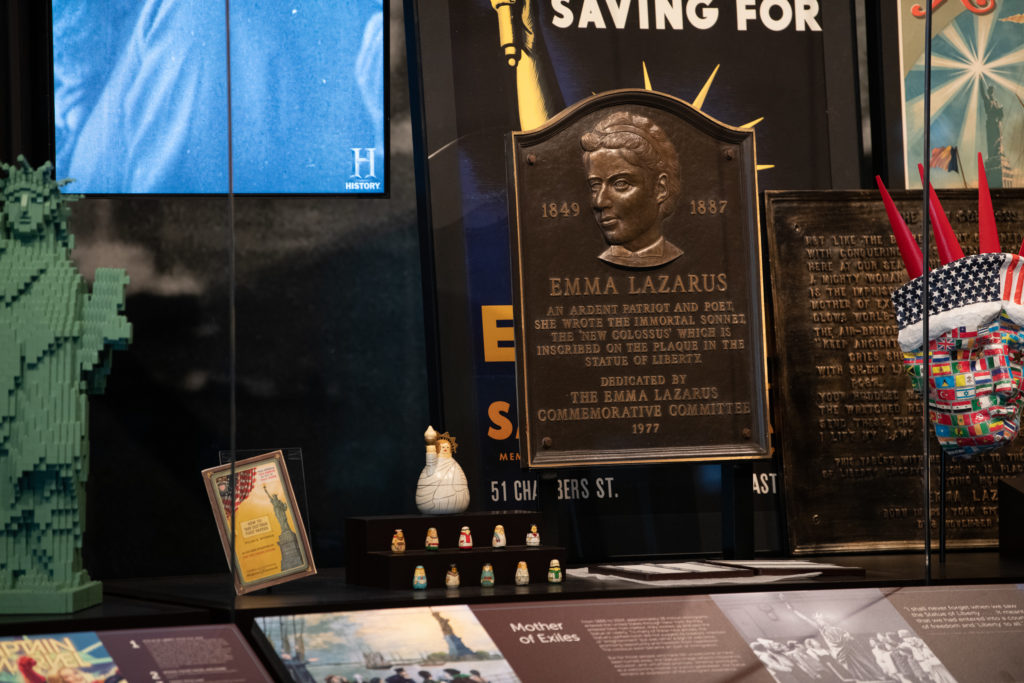Ladies of Liberty: Caroline Rojek, Senior Media Producer at ESI Design
Posted January 6, 2020
In May 2019, the new Statue of Liberty Museum opened on Liberty Island with experience and exhibits by ESI Design. The new museum is part of a $100 million Liberty Island-wide beautification effort that is funded by our clients, The Statue of Liberty-Ellis Island Foundation.
To celebrate we’re sharing the stories of some of the talented people who have worked for over five years to bring this world-class museum from concept to completion.
In this edition, you’ll hear from Caroline Rojek, a Senior Media Producer at ESI Design, who worked on the experience and exhibit design for the museum. Caroline used her educational background in museum studies to help craft immersive experiences for visitors of the Statue of Liberty Museum.

Name: Caroline Rojek
Job Title: Senior Media Producer, ESI Design
Years of Experience: 7 years
Age: 36
Nationality: United States
Languages Spoken: English
Education: Bachelors degree in American Studies from The George Washington University, masters in Museum Studies from New York University
What was your first encounter with the Statue of Liberty?
Caroline Rojek, Senior Media Producer: I first visited the Statue when I was about 8 years old. My cousins lived just north of the city at the time, and we would make yearly trips to see them and explore the city. I remember waiting in a really long line to climb to the crown. It was a step by step wait all the way to the top, and despite the many visitors, it felt so immense. I was totally in awe of it.
What was your role on the project? What did that mean for you day-to-day?
CR: I was the Media Producer for all of the media content and interactives, except for the film. I was responsible for managing the team involved in the content scripting, visual design, sound design and software logic that went into all of these areas.
The most challenging aspect of our work is to take the elements we’ve designed and bring them into the space for the first time. So much of our work happens outside of the space, so you always have to accommodate unexpected elements once you begin final programming. My favorite moment was seeing visitors viewing and interacting with all of the content we created for the first time. Visitors are the most important element of the design, so it is hugely gratifying to see them bring our work to life.

You just opened a new museum for the Statue of Liberty — how does that feel? What does that mean to you?
CR: My educational background is in American History, Culture and Museums, and I worked several years in museums before starting at ESI. So, being on the Statue of Liberty Museum project was really going back to my roots. Museums are incredible facilitators for some of our most difficult conversations as a nation.
Why is having a museum dedicated to the Statue of Liberty important?
CR: Liberty is an ideal that we hold so high as Americans, but we continually find ourselves in conflict trying to define it. Creating a space where this dialogue is safe and people from all over the world can partake in the experience and conversation is crucial.

After working on this project, has your concept of liberty evolved?
CR: I have always understood what Liberty means to me, but what was so gratifying about working on this project was the ever-evolving dialogue of what Liberty means to people across the country and across the globe. That conversation is at the heart of what Liberty truly is – the ability to coexist despite differing identities and ideals.
What were the steps in your journey to this iconic project?
CR: I come from a museum background; I went to graduate school for museum studies and I have worked in museums and museum collections leading up to my start at ESI. While I am not on the design side of the work we do here — I’m on the production side — this was my first museum project at ESI Design, and it was really great to get back to my roots in terms of the type of content we were developing and the type of audience we were creating that content for.

Since you started your career, what’s the biggest change you have seen in the world of design?
CR: There is so much more integration of media into exhibitions. This allows for pieces of the collection that aren’t normally highlighted because of the limited display capacity to get noticed. This allows people to have access to things they couldn’t previously see or touch, and you get to use technology to highlight them. For example, the poster interactive at the museum allows you to go through over a hundred posters that are in the collection. Without technology, there would never be room to display all of them. Additionally, museums are always trying to engage people in different ways, and technology is one of the great ways to do that, especially with something like the exhibit Becoming Liberty, where you get to put yourself into the story of what “liberty” is. Becoming Liberty represents a huge shift toward what museums are trying to do as technology gets better and better. The ways in which people can interact with the story that’s being told are becoming greater and greater.
What advice would you give to your younger self starting a career in design?
CR: Coming out of college, I was definitely more of a content person. I was really interested in history, American studies and cultural perspectives. My first jobs were really about the content, but at a certain point I realized in the field of museums it can be difficult to move up the ladder as there are not a ton of jobs. In academia, people stay in their jobs for a long time. Coming to ESI was like coming to the other side of the fence by working for a company that creates exhibitions for museums. Doing that opened me up to media, which I hadn’t worked in before. It allowed me to diversify the type of work I did while staying true to the principles I learned while coming up in the museum world.
My advice to women, and to people in general, would be that even if you are going down a specific path, there are always skills and attributes of the work you do that can be applied to different careers. There might be overlaps, or they might be tangential to each other. There is a way to keep reinventing yourself and follow a different path. When I went to school, I honed in on a very specific niche. But when I came out of school and entered the real world, I saw how many opportunities were really available for that specific career, and it was limited. I knew that I would need to pivot a little bit, and still be involved in the same type of content and principles of how we work and our work’s importance, but come at it from a different angle.

If you were giving a tour of the new museum, what would be your top highlight?
CR: One of the objects I really love is the nesting doll set. They are hand painted and kind of folk art-y, which appeals to me on a personal level. I love all of the ways in which the statue gets represented by individual people, and how they interpret its meaning to then create an object of it. I think that is a nice parallel to how people use the Becoming Liberty interactive, where they create what “liberty” means to them in a digital form. The nesting dolls are an analogue, folk art form, so I really love that.
Something we did on the media side that I also think is very important are the different soundscapes that you hear in the galleries. I think sometimes we don’t realize the importance of ambient sounds. There are also instances where we pulled archival songs, speeches and oral histories. That texture added on to the visuals that you see is really wonderful; it is subtle, but super impactful.
Read more about the museum’s soundscapes, designed by Jeremy Bloom here.


Join The Conversation